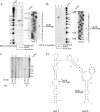Autoregulation of AbsB (RNase III) expression in Streptomyces coelicolor by endoribonucleolytic cleavage of absB operon transcripts
- PMID: 18539734
- PMCID: PMC2493247
- DOI: 10.1128/JB.00558-08
Autoregulation of AbsB (RNase III) expression in Streptomyces coelicolor by endoribonucleolytic cleavage of absB operon transcripts
Abstract
The Streptomyces coelicolor absB gene encodes an RNase III family endoribonuclease and is normally essential for antibiotic biosynthesis. Here we report that AbsB controls its own expression by sequentially and site specifically cleaving stem-loop segments of its polycistronic transcript. Our results demonstrate a ribonucleolytic regulatory role for AbsB in vivo.
Figures



References
-
- Amarasinghe, A. K., I. Calin-Jageman, A. Harmouch, W. Sun, and A. W. Nicholson. 2001. Escherichia coli ribonuclease III: affinity purification of hexahistidine-tagged enzyme and assays for substrate binding and cleavage. Methods Enzymol. 342143-158. - PubMed
-
- Bernstein, E., A. A. Caudy, S. M. Hammond, and G. J. Hannon. 2001. Role for a bidentate ribonuclease in the initiation step of RNA interference. Nature 409363-366. - PubMed
-
- Bibb, M. 1996. 1995 Colworth Prize Lecture. The regulation of antibiotic production in Streptomyces coelicolor A3(2). Microbiology 1421335-1344. - PubMed
Publication types
MeSH terms
Substances
Grants and funding
LinkOut - more resources
Full Text Sources

